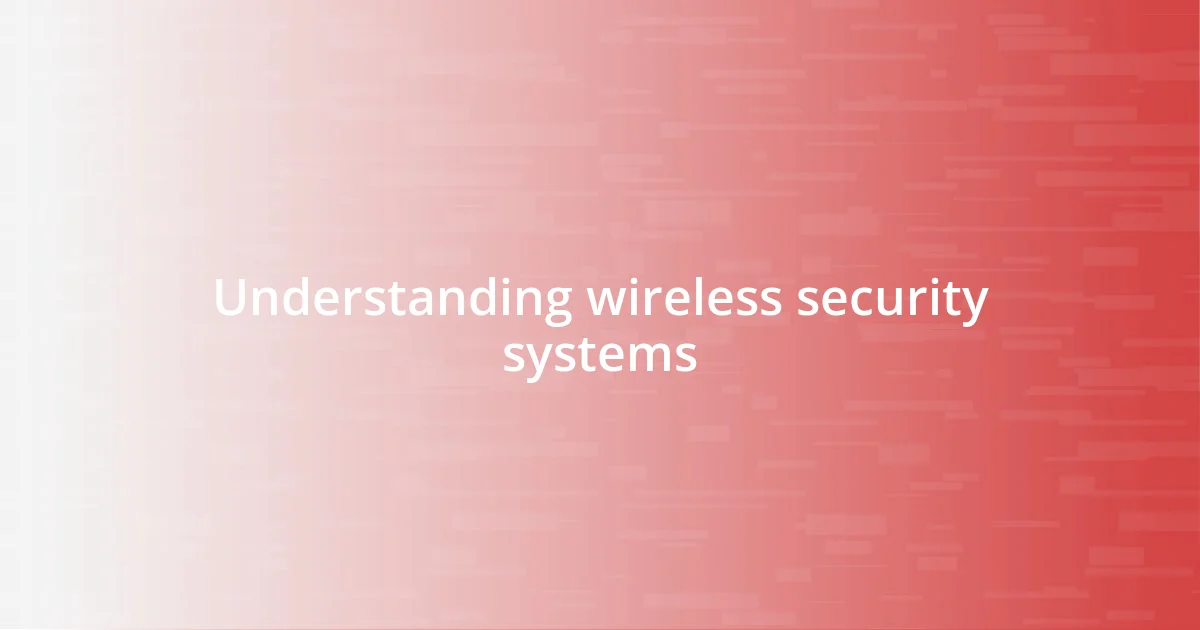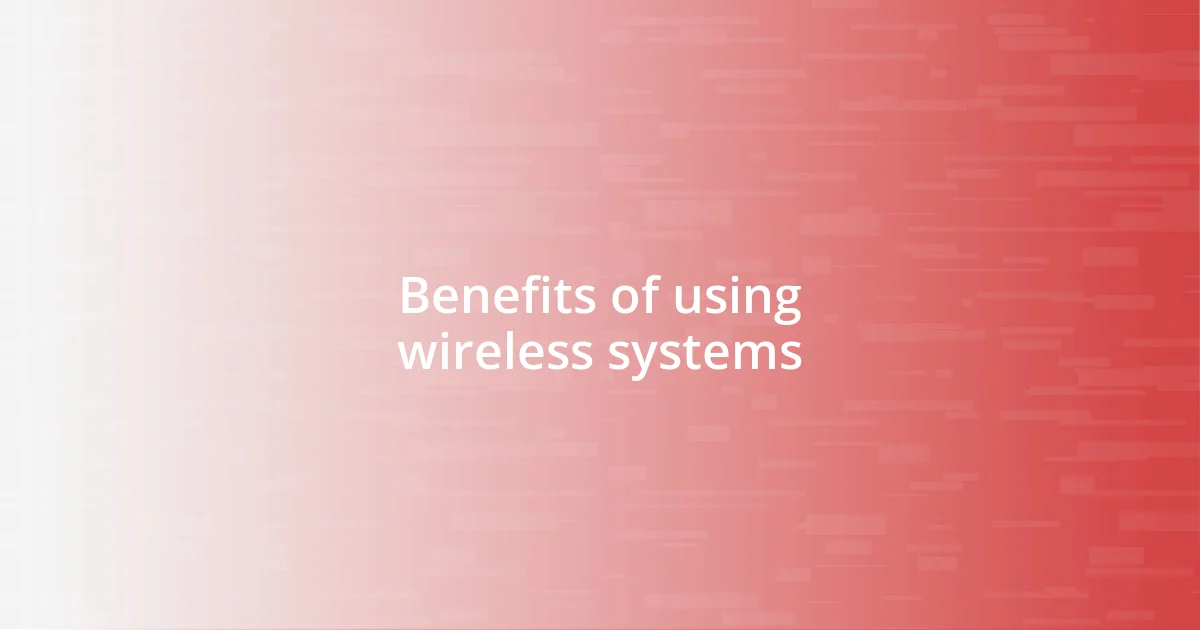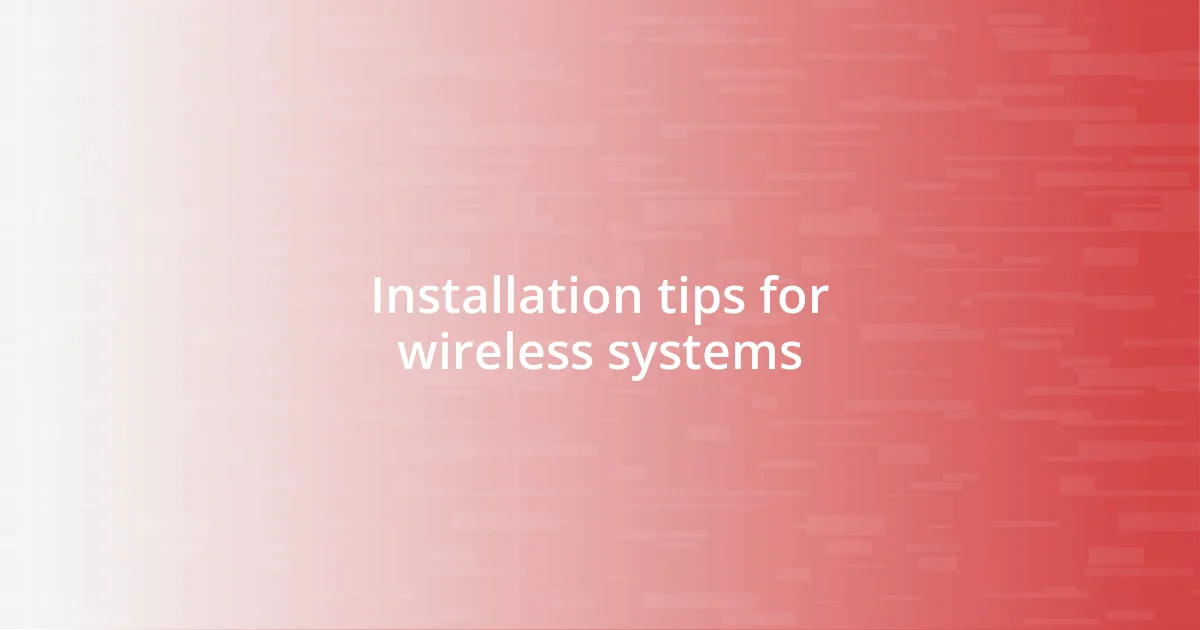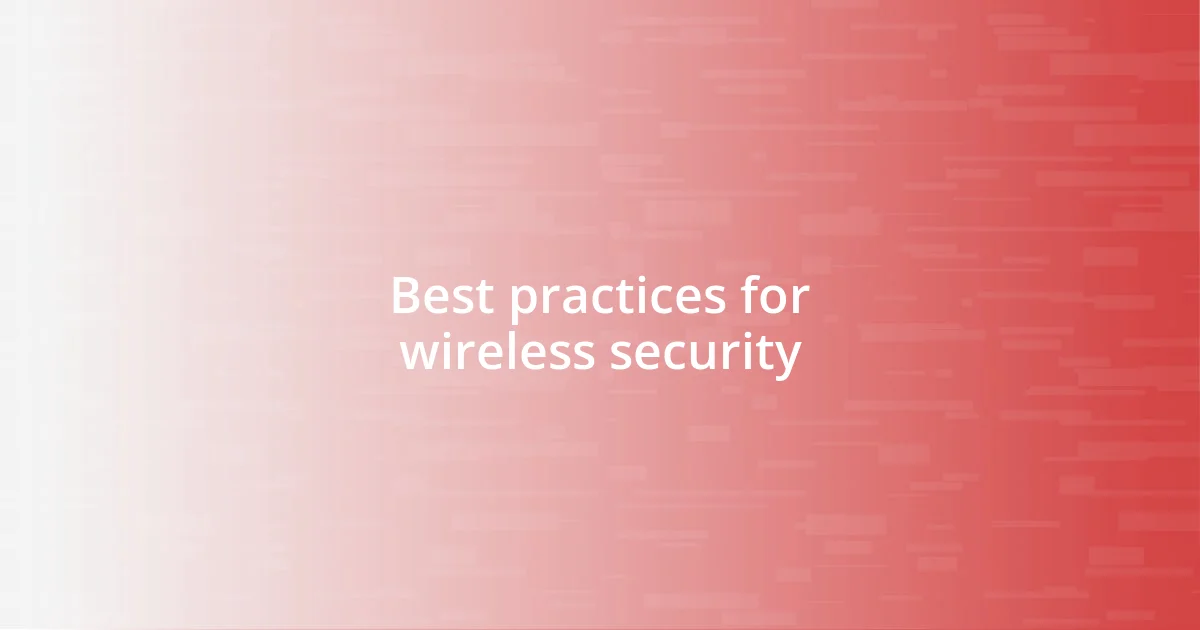Key takeaways:
- Understanding signal strength, encryption, and regular firmware updates are crucial for maximizing the effectiveness and security of wireless systems.
- Key benefits of wireless systems include ease of installation, flexibility, cost-effectiveness, remote access, and improved aesthetics.
- Best practices for wireless security include routinely changing passwords, utilizing encryption, and regularly monitoring system activity to identify potential threats.

Understanding wireless security systems
Wireless security systems have become increasingly popular due to their convenience and flexibility. I remember installing my first wireless camera to monitor my home when I was away. The relief I felt knowing I could check in from my phone was priceless – it made me realize how these systems provide peace of mind in today’s fast-paced world.
While these systems are user-friendly, understanding their inner workings is key to maximizing their benefits. Take, for instance, the importance of signal strength. Have you ever experienced dropouts or lag in your connection? I certainly have, and it taught me that positioning your devices carefully can make a significant difference in their effectiveness.
Moreover, the technology behind wireless security systems involves various protocols that ensure secure communication. For example, I’ve learned that encryption can prevent unauthorized access to your camera feeds and data. Isn’t it reassuring to know that, while technology can feel daunting, understanding these fundamentals can empower you to make informed decisions for your safety?

Benefits of using wireless systems
One major benefit of using wireless security systems is their ease of installation. I vividly remember how simple it was to set up my wireless alarm system compared to traditional wired options. I didn’t have to drill holes or wrestle with complicated wiring—just plug in the devices, connect to Wi-Fi, and voilà ! That straightforward setup not only saved me time but also made it more accessible for others who might not be tech-savvy.
Here are several key benefits of choosing wireless systems:
- Flexibility: You can easily move devices around your property without hassle.
- Scalability: It’s straightforward to add new cameras or sensors as your needs change.
- Cost-Effectiveness: There’s often no need for expensive installation fees associated with wired systems.
- Remote Access: I love being able to monitor my home via an app, whether I’m a few blocks away or on vacation.
- Aesthetics: With no unsightly wires, my home looks cleaner and more appealing.
Honestly, embracing wireless technology has not just enhanced my security; it’s also brought a sense of control into my daily life. I find it incredibly empowering to stay connected and informed, no matter where I am.

Common security risks and vulnerabilities
When it comes to wireless security systems, I’ve come across several common security risks and vulnerabilities that users should be aware of. One major concern is unauthorized access due to weak passwords. I once learned this the hard way when a friend’s camera feed was hacked simply because they used “123456” as their password. It’s remarkable how something so simple can undermine the entire security setup. Always opt for strong, complex passwords and regularly update them.
Another risk I’ve noticed is signal interference. I remember a time when my Wi-Fi router was in a corner of my home, and my outdoor security camera struggled to maintain a connection. This situation not only left me vulnerable at night but also led to blind spots in my surveillance coverage. It’s a reminder that physical obstructions and competing devices can significantly affect performance, so positioning your routers and devices thoughtfully is crucial.
Lastly, outdated firmware can be a silent yet serious vulnerability. I never used to think much about firmware updates until I read about a security breach due to outdated software. I make it a point to check for updates regularly now. It’s one of those small maintenance tasks that can provide substantial protection against potential threats, turning my home into a fortress rather than a target.
| Security Risk | Description |
|---|---|
| Unauthorized Access | Weak passwords can lead to easy hacking of devices. |
| Signal Interference | Physical obstructions affect device connectivity and coverage. |
| Outdated Firmware | Failing to update software may leave systems open to vulnerabilities. |

Installation tips for wireless systems
When installing a wireless system, I cannot stress enough the importance of choosing the right location for your devices. I learned this the hard way when I placed my security camera too close to a large tree. The camera struggled with its connection during stormy weather, leaving gaps in my monitoring when I needed it the most. Have you ever found yourself wondering why your device isn’t functioning quite right? It often comes down to position; careful placement away from obstructions can make all the difference.
Don’t overlook the importance of securing your network during installation, either. After setting up my system, I spent time ensuring my Wi-Fi settings were robust. It’s like locking your front door after you come home; you just feel safer knowing your system isn’t exposed to vulnerabilities. I even consider running a separate network just for my security devices. It’s an extra layer of protection that gives me peace of mind.
Finally, remember that regular testing of your devices is essential. I’ve set a personal reminder to check each component monthly—batteries, connectivity, and even the alarm loudness. When I realized my door sensor wasn’t working properly because the battery had died, it made me feel vulnerable. I quickly implemented a routine check, and it’s rewarding knowing I’m proactive in keeping my home safe. How often do we think about these small tasks? It may seem tedious, but it truly pays off in the long run.

Best practices for wireless security
I’ve found that one of the best practices for wireless security is to routinely change your passwords. Initially, I thought setting a strong password once was enough, but it became clear that the longer I used the same login, the more vulnerable my system felt. It’s a bit like leaving your front door unlocked—crucial things should never be taken for granted. I now make it a habit to change passwords every few months, which not only boosts security but gives me peace of mind.
Another key aspect I’ve learned is to utilize encryption for your wireless network. I remember a friend’s face when their camera footage was accessed by a neighbor thanks to unprotected Wi-Fi. It was a wake-up call! Implementing WPA3 encryption has become a standard for me now. It’s a simple step, yet it fortifies my security systems against unwanted guests. Are you taking similar precautions with your network? If not, it’s definitely time to consider it.
Don’t underestimate the power of regularly monitoring your system’s activity. I was once surprised to discover how frequently my surveillance cameras flagged movement at odd hours. Keeping an eye on this data can reveal suspicious patterns or issues that may not be immediately noticeable. It’s like having a vigilant neighbor who always watches over your home. Integrating this into my routine has allowed me to stay ahead of potential security problems, proving invaluable in keeping my space safe.












